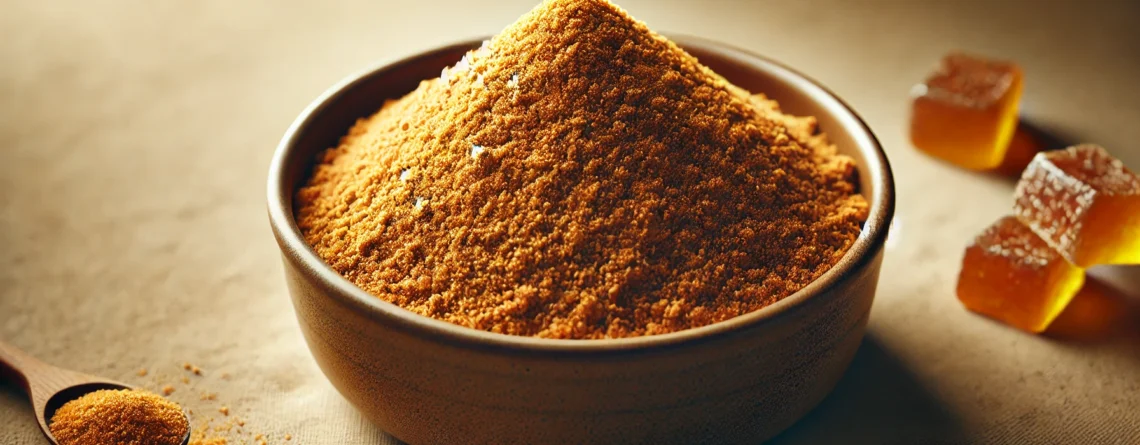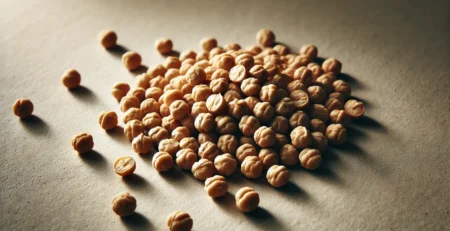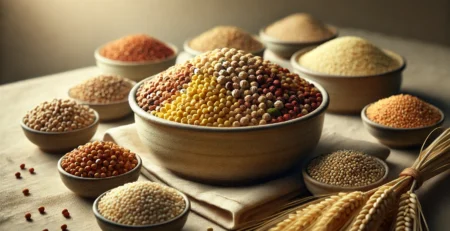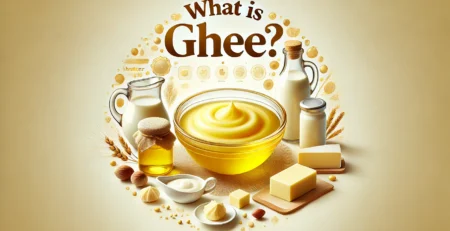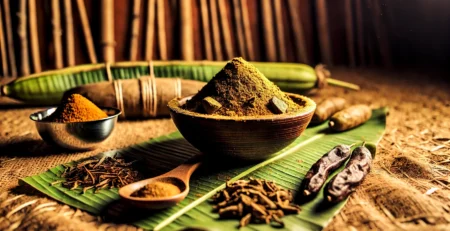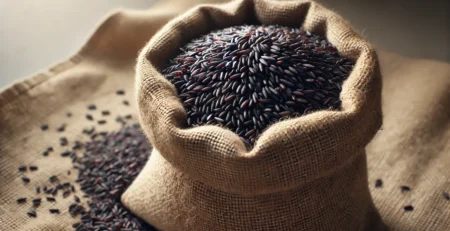What is Jaggery Powder? Health Benefits, Uses, and Cultural Significance
Jaggery Powder: The Sweet Gold of Ancient Traditions
Jaggery powder, often referred to as “gur” in India, is a traditional, unrefined sweetener derived from sugarcane or palm sap. Unlike refined sugar, jaggery retains many of its natural minerals and nutrients, making it a popular choice for health-conscious individuals. This comprehensive guide will explore the origins, production process, health benefits, and culinary uses of jaggery powder, along with its cultural significance in various parts of the world.
Table of Contents
| Sections | Subsections |
|---|---|
| 1. Introduction | 1.1 What is Jaggery Powder? |
| 1.2 Historical Background of Jaggery | |
| 1.3 Importance in Modern Diets | |
| 2. The Production Process of Jaggery Powder | 2.1 Harvesting the Raw Material |
| 2.2 Extraction of Juice from Sugarcane and Palm | |
| 2.3 Boiling and Concentration of the Juice | |
| 2.4 Crystallization and Solidification | |
| 2.5 Pulverizing and Packaging | |
| 3. Types of Jaggery | 3.1 Sugarcane Jaggery |
| 3.2 Palm Jaggery | |
| 3.3 Coconut Jaggery | |
| 3.4 Date Palm Jaggery | |
| 4. Nutritional Composition | 4.1 Macronutrients in Jaggery Powder |
| 4.2 Micronutrients and Minerals | |
| 4.3 Comparative Analysis with Refined Sugar | |
| 5. Health Benefits of Jaggery Powder | 5.1 Aids in Digestion |
| 5.2 Detoxification of the Liver | |
| 5.3 Boosts Immunity | |
| 5.4 Rich in Antioxidants | |
| 5.5 Benefits for Anemia | |
| 5.6 Prevention of Respiratory Issues | |
| 6. Culinary Uses of Jaggery Powder | 6.1 Sweetening Agent in Desserts |
| 6.2 Ingredient in Traditional Recipes | |
| 6.3 Use in Beverages and Drinks | |
| 6.4 Flavor Enhancer in Savory Dishes | |
| 7. Jaggery in Different Cultures | 7.1 India: The Birthplace of Jaggery |
| 7.2 Southeast Asia: A Culinary Staple | |
| 7.3 Africa: Traditional Sweetener | |
| 7.4 Latin America: Panela and Its Variations | |
| 8. Jaggery Powder in Ayurveda and Traditional Medicine | 8.1 Role in Ayurvedic Practices |
| 8.2 Jaggery in Traditional Home Remedies | |
| 8.3 Modern Scientific Studies on Jaggery’s Health Effects | |
| 9. Economic and Environmental Impact | 9.1 Role in Rural Economies |
| 9.2 Sustainable Production Practices | |
| 9.3 Impact on Local and Global Markets | |
| 10. Jaggery Powder vs. Other Sweeteners | 10.1 Comparison with White Sugar |
| 10.2 Comparison with Honey and Maple Syrup | |
| 10.3 Jaggery vs. Brown Sugar | |
| 11. How to Incorporate Jaggery Powder in Your Diet | 11.1 Daily Consumption Tips |
| 11.2 Recipes Featuring Jaggery Powder | |
| 11.3 Substituting Jaggery Powder in Baking and Cooking | |
| 12. Storage and Shelf Life of Jaggery Powder | 12.1 Proper Storage Techniques |
| 12.2 Signs of Spoilage | |
| 12.3 Extending the Shelf Life | |
| 13. Frequently Asked Questions (FAQs) | 13.1 What is jaggery powder made from? |
| 13.2 Is jaggery healthier than sugar? | |
| 13.3 Can diabetics consume jaggery powder? | |
| 13.4 How is jaggery powder different from regular jaggery? | |
| 13.5 Where can I buy jaggery powder? | |
| 13.6 How much jaggery powder can be consumed in a day? | |
| 14. Conclusion | 14.1 Summary of Key Points |
| 14.2 The Future of Jaggery Powder | |
| 14.3 Final Thoughts on Incorporating Jaggery into a Balanced Diet |
1. Introduction
1.1 What is Jaggery Powder?
Jaggery powder is a natural sweetener made from the concentrated juice of sugarcane or palm. Unlike refined sugar, which undergoes extensive processing to remove molasses and other nutrients, jaggery retains most of its natural molasses, minerals, and vitamins. The process of making jaggery involves boiling the juice until it solidifies, then breaking it down into a granular form that resembles brown sugar. The resulting product is a golden-brown powder with a distinct, earthy flavor that is less sweet than sugar but richer in nutrients.
1.2 Historical Background of Jaggery
Jaggery has a long history dating back to ancient civilizations in India and Southeast Asia. In India, jaggery has been used for over 5,000 years as a sweetener and as an essential ingredient in traditional Ayurvedic medicine. The production of jaggery is mentioned in early Sanskrit texts, and it has been an integral part of the Indian diet for millennia.
Historically, jaggery was produced and consumed in regions where sugarcane was abundant. Its production spread across Asia and Africa, where it became a staple sweetener in various cultures. In ancient times, jaggery was not just a food item but also a commodity for trade. It was valued not only for its sweetening properties but also for its medicinal benefits and nutritional value.
1.3 Importance in Modern Diets
In today’s health-conscious world, jaggery powder has gained popularity as a healthier alternative to refined sugar. With the increasing awareness of the negative health impacts of excessive sugar consumption, many people are turning to natural sweeteners like jaggery. Its rich nutrient profile, which includes iron, calcium, magnesium, and potassium, makes it a preferred choice for those looking to maintain a balanced diet without compromising on sweetness.
Jaggery powder is also prized for its digestive benefits and its ability to provide a quick energy boost. Unlike refined sugar, which is considered “empty calories,” jaggery powder offers nutritional value, making it a more wholesome addition to various dishes and beverages.
2. The Production Process of Jaggery Powder
The production of jaggery powder is an artisanal process that has been passed down through generations. Each step, from harvesting the raw materials to packaging the final product, requires careful attention to detail to ensure that the jaggery retains its natural goodness.
2.1 Harvesting the Raw Material
The primary raw materials for jaggery production are sugarcane and palm sap. Sugarcane is the most common source, especially in India, where vast fields of sugarcane are cultivated specifically for jaggery production. The cane is harvested when it reaches peak maturity to ensure maximum juice content.
Palm sap, derived from various types of palm trees such as date palm, coconut palm, and toddy palm, is another popular source of jaggery, especially in Southeast Asia and parts of Africa. The sap is collected by making incisions in the bark of the palm tree, allowing the sweet liquid to flow into containers.
2.2 Extraction of Juice from Sugarcane and Palm
Once the sugarcane or palm sap is harvested, the next step is to extract the juice. For sugarcane, the cane is fed through a crusher, which presses out the juice. The juice is then filtered to remove impurities such as dirt and fibers.
For palm sap, the collected liquid is naturally clean and is often used immediately for jaggery production. However, it is sometimes filtered to ensure that no debris is present.
2.3 Boiling and Concentration of the Juice
The extracted juice is transferred to large, shallow pans made of iron or copper. These pans are placed over a wood-fired furnace, and the juice is boiled for several hours. During this process, the juice is constantly stirred to prevent it from sticking to the pan and burning. The heat causes the water in the juice to evaporate, and the juice begins to thicken.
As the juice boils, impurities rise to the surface and are skimmed off to ensure the final product is clean and pure. The boiling process continues until the juice reaches the desired consistency and color, which is typically a deep golden brown.
2.4 Crystallization and Solidification
Once the juice has thickened, it is poured into molds or allowed to cool in large trays. As it cools, the thickened juice begins to solidify and crystallize. The cooling process is crucial as it determines the texture of the final product. For jaggery powder, the mixture is allowed to cool just enough to begin solidifying before it is broken down into small granules.
2.5 Pulverizing and Packaging
The solidified jaggery is then transferred to a crusher or grinder, where it is pulverized into a fine powder. This powder is sifted to ensure uniform consistency, with any larger particles being crushed again.
Once the jaggery has been transformed into powder form, it is carefully packaged to maintain its freshness. Proper packaging is essential to prevent moisture from entering, as jaggery powder is hygroscopic and can easily clump if exposed to humidity.
3. Types of Jaggery
Jaggery comes in various forms, depending on the source of the raw material and the region of production. Each type of jaggery has a unique flavor profile and is used differently in culinary practices.
3.1 Sugarcane Jaggery
Sugarcane jaggery is the most common type of jaggery and is primarily produced in India. It is made from the juice of sugarcane and has a rich, caramel-like flavor. This type of jaggery is often used in Indian sweets, snacks, and beverages.
3.2 Palm Jaggery
Palm jaggery is made from the sap of various palm trees, such as the date palm or toddy palm. It is darker in color compared to sugarcane jaggery and has a more intense, earthy flavor. Palm jaggery is commonly used in Southeast Asian and African cuisines.
3.3 Coconut Jaggery
Coconut jaggery is produced from the sap of coconut palm trees. It has a distinct flavor that combines the sweetness of coconut with the rich taste of jaggery. Coconut jaggery is popular in South India and Sri Lanka, where it is used in traditional desserts.
3.4 Date Palm Jaggery
Date palm jaggery is made from the sap of the date palm tree. It is highly prized for its unique taste, which is both sweet and slightly smoky. Date palm jaggery is a staple in the Middle East and North Africa, where it is used in both sweet and savory dishes.
4. Nutritional Composition
One of the main reasons jaggery powder is favored over refined sugar is its rich nutritional profile. Jaggery is packed with essential vitamins and minerals that contribute to overall health and well-being.
4.1 Macronutrients in Jaggery Powder
Jaggery powder primarily consists of carbohydrates, which provide a quick source of energy. It contains small amounts of proteins and fats, though these are not significant. The carbohydrates in jaggery are more complex than those in refined sugar, leading to a slower release of energy and a more sustained effect.
4.2 Micronutrients and Minerals
Jaggery powder is an excellent source of several essential minerals, including:
- Iron: Jaggery is particularly rich in iron, making it an excellent dietary addition for those at risk of anemia.
- Calcium: Important for bone health, calcium is present in significant amounts in jaggery powder.
- Magnesium: This mineral plays a vital role in metabolic processes and muscle function.
- Potassium: Jaggery contains potassium, which helps regulate blood pressure and maintain electrolyte balance.
Additionally, jaggery contains trace amounts of zinc, phosphorus, and copper, all of which contribute to its health benefits.
4.3 Comparative Analysis with Refined Sugar
Unlike refined sugar, which is stripped of all nutrients during processing, jaggery retains its natural minerals and vitamins. Refined sugar is composed almost entirely of sucrose and provides only empty calories, leading to rapid spikes in blood sugar levels. In contrast, jaggery’s complex carbohydrates and micronutrient content offer a slower energy release and additional health benefits.
5. Health Benefits of Jaggery Powder
Jaggery powder is more than just a sweetener; it offers several health benefits, making it a valuable addition to a balanced diet.
5.1 Aids in Digestion
Jaggery powder is known for its ability to aid digestion. It stimulates the secretion of digestive enzymes, which helps in breaking down food more efficiently. Consuming a small piece of jaggery after meals is a common practice in India to promote digestion and prevent constipation.
5.2 Detoxification of the Liver
Jaggery powder acts as a natural detoxifier, particularly for the liver. It helps cleanse the liver by flushing out harmful toxins from the body. Regular consumption of jaggery powder can support liver function and overall detoxification processes.
5.3 Boosts Immunity
The rich mineral content in jaggery powder, particularly iron and zinc, contributes to strengthening the immune system. These minerals play a crucial role in maintaining immune responses and protecting the body against infections.
5.4 Rich in Antioxidants
Jaggery powder contains natural antioxidants, which help in fighting oxidative stress and protecting cells from damage caused by free radicals. This antioxidant property also contributes to the anti-aging effects of jaggery, keeping skin healthy and reducing the risk of chronic diseases.
5.5 Benefits for Anemia
Due to its high iron content, jaggery powder is an effective remedy for anemia. It helps increase hemoglobin levels in the blood, making it an ideal dietary supplement for those with iron deficiency.
5.6 Prevention of Respiratory Issues
Jaggery powder is often used in traditional remedies to prevent and treat respiratory problems such as asthma, bronchitis, and coughs. Its anti-inflammatory properties help soothe the respiratory tract, while its natural sweetness makes it easier to consume with other medicinal herbs.
6. Culinary Uses of Jaggery Powder
Jaggery powder is incredibly versatile in the kitchen and is used in various cuisines around the world.
6.1 Sweetening Agent in Desserts
Jaggery powder is a popular sweetening agent in traditional desserts, especially in South Asia. It is used in preparing sweets like laddus, halwas, and payasams, where its rich flavor enhances the taste of the dish. The earthy sweetness of jaggery pairs well with ingredients like coconut, cardamom, and nuts.
6.2 Ingredient in Traditional Recipes
In addition to desserts, jaggery powder is used in many traditional recipes. For example, it is a key ingredient in the making of chikki (a type of brittle made with peanuts), and it is also used in savory dishes like sambar, a South Indian lentil stew, to balance the flavors.
6.3 Use in Beverages and Drinks
Jaggery powder is commonly used to sweeten beverages, both hot and cold. It can be added to tea, coffee, or even smoothies as a healthier alternative to sugar. In some regions, jaggery is dissolved in water and consumed as a refreshing drink, known as “jaggery water,” which is believed to have cooling properties.
6.4 Flavor Enhancer in Savory Dishes
Jaggery powder is not just limited to sweet dishes; it is also used as a flavor enhancer in savory dishes. In Indian cuisine, a small amount of jaggery is often added to curries, chutneys, and sauces to balance out spicy and tangy flavors. This practice is especially common in Gujarati and Maharashtrian cuisines, where the balance of sweet, sour, and spicy is essential.
7. Jaggery in Different Cultures
Jaggery holds cultural significance in many parts of the world, especially in Asia and Africa. It is not just a sweetener but a part of the cultural and culinary heritage of several regions.
7.1 India: The Birthplace of Jaggery
India is considered the birthplace of jaggery, where it has been produced and consumed for thousands of years. In Indian culture, jaggery is associated with festivals and rituals. It is used in offerings to deities and in preparing special dishes during religious ceremonies. The production of jaggery in India is an age-old tradition, with specific regions like Maharashtra, Uttar Pradesh, and Karnataka being famous for their high-quality jaggery.
7.2 Southeast Asia: A Culinary Staple
In Southeast Asia, jaggery is a culinary staple, especially in countries like Thailand, Indonesia, and the Philippines. Here, jaggery is often made from palm sap and is used extensively in both sweet and savory dishes. It is a key ingredient in traditional recipes like Thai curries, Indonesian desserts, and Filipino snacks.
7.3 Africa: Traditional Sweetener
In Africa, particularly in countries like Nigeria and Kenya, jaggery is produced from sugarcane and is used as a traditional sweetener. It is also used in local beverages and as a flavoring agent in various traditional dishes. In some African communities, jaggery is made from palm sap, similar to the process in Southeast Asia.
7.4 Latin America: Panela and Its Variations
In Latin America, jaggery is known as “panela” or “rapadura” and is widely consumed in countries like Colombia, Brazil, and Mexico. Panela is made from sugarcane juice and is an integral part of the local diet. It is used in making desserts, beverages, and even traditional remedies. In Colombia, for instance, panela is dissolved in water to make a popular drink called “aguapanela,” which is often consumed with lime juice.
8. Jaggery Powder in Ayurveda and Traditional Medicine
Jaggery has been used for centuries in Ayurvedic practices and traditional medicine systems due to its numerous health benefits.
8.1 Role in Ayurvedic Practices
In Ayurveda, jaggery is considered a sattvic food, meaning it promotes harmony and balance in the body and mind. It is used in various Ayurvedic formulations to treat conditions like coughs, colds, and digestive issues. Jaggery is also believed to purify the blood, improve digestion, and enhance overall vitality.
8.2 Jaggery in Traditional Home Remedies
Traditional home remedies often include jaggery as a key ingredient due to its medicinal properties. For instance, jaggery mixed with ginger or black pepper is commonly used to alleviate symptoms of cough and cold. In rural India, jaggery is sometimes used as a natural remedy for menstrual cramps and other minor ailments.
8.3 Modern Scientific Studies on Jaggery’s Health Effects
Modern science has begun to validate many of the traditional uses of jaggery. Studies have shown that jaggery can help in preventing iron deficiency anemia, improving digestion, and boosting the immune system. Research has also explored jaggery’s role in detoxification and its potential antioxidant and anti-inflammatory properties.
9. Economic and Environmental Impact
Jaggery production is not only important for cultural and dietary reasons but also has significant economic and environmental implications.
9.1 Role in Rural Economies
The production of jaggery plays a vital role in supporting rural economies, particularly in India and Southeast Asia. Many small-scale farmers and rural communities depend on jaggery production as a primary source of income. The industry provides employment to thousands of people, from farmers who grow sugarcane or tap palm sap to workers who process and package the jaggery.
9.2 Sustainable Production Practices
Jaggery production is often more sustainable compared to the production of refined sugar. The process is less energy-intensive and involves fewer chemicals, making it an environmentally friendly alternative. Moreover, the use of traditional methods and local resources in jaggery production helps in preserving biodiversity and reducing the carbon footprint.
9.3 Impact on Local and Global Markets
Jaggery has a significant impact on both local and global markets. In regions where it is produced, jaggery is a staple commodity that is traded extensively. On a global scale, the demand for natural and organic products has increased the export of jaggery to markets in Europe, North America, and other parts of the world. This growing demand has created new opportunities for farmers and producers in developing countries.
10. Jaggery Powder vs. Other Sweeteners
When it comes to choosing a sweetener, jaggery powder stands out due to its nutritional benefits and unique flavor. Here’s how it compares to other common sweeteners:
10.1 Comparison with White Sugar
White sugar is highly refined and contains no nutrients, making it a source of empty calories. In contrast, jaggery powder retains its natural minerals and vitamins, offering a more nutritious alternative. Jaggery also has a lower glycemic index than white sugar, meaning it causes a slower rise in blood sugar levels.
10.2 Comparison with Honey and Maple Syrup
Honey and maple syrup are also natural sweeteners, like jaggery. While all three contain beneficial nutrients, jaggery is particularly rich in iron and other minerals. Honey has antibacterial properties, and maple syrup is high in antioxidants, but jaggery’s higher mineral content gives it an edge for those looking to boost their intake of essential nutrients.
10.3 Jaggery vs. Brown Sugar
Brown sugar is often marketed as a healthier alternative to white sugar, but it is essentially refined sugar with molasses added back in. Jaggery, on the other hand, is a more natural product that undergoes minimal processing, retaining more of its original nutrients. Additionally, jaggery has a more complex flavor compared to the relatively bland taste of brown sugar.
11. How to Incorporate Jaggery Powder in Your Diet
Incorporating jaggery powder into your diet is easy and can add both flavor and nutritional value to your meals.
11.1 Daily Consumption Tips
A small amount of jaggery powder can be included in your daily diet as a sweetener in beverages, desserts, or even savory dishes. Start by replacing refined sugar with jaggery in your tea or coffee. You can also sprinkle jaggery powder on cereals, yogurt, or oatmeal for a naturally sweet start to your day.
11.2 Recipes Featuring Jaggery Powder
Here are a few recipes that showcase the versatility of jaggery powder:
- Jaggery Rice: A traditional Indian dish made by cooking rice with jaggery, ghee, and spices like cardamom and cloves.
- Ginger Jaggery Tea: A warming beverage made by brewing tea with fresh ginger and sweetening it with jaggery powder.
- Peanut Jaggery Laddus: These energy-boosting sweets are made by mixing roasted peanuts with melted jaggery and shaping them into balls.
11.3 Substituting Jaggery Powder in Baking and Cooking
Jaggery powder can be used as a substitute for sugar in most baking and cooking recipes. When substituting, use a 1:1 ratio, though you may need to adjust for the moisture content, as jaggery is more hydrating than sugar. Jaggery adds a deep, caramel-like flavor to baked goods, making it perfect for recipes like cookies, cakes, and muffins.
12. Storage and Shelf Life of Jaggery Powder
Proper storage is key to maintaining the quality of jaggery powder.
12.1 Proper Storage Techniques
Jaggery powder should be stored in an airtight container to prevent exposure to moisture, which can cause it to clump or spoil. Keep the container in a cool, dry place away from direct sunlight. If you live in a humid environment, consider storing jaggery powder in the refrigerator to extend its shelf life.
12.2 Signs of Spoilage
Jaggery powder can spoil if not stored properly. Signs of spoilage include a change in color, the presence of mold, or a sour smell. If you notice any of these signs, it’s best to discard the jaggery.
12.3 Extending the Shelf Life
To extend the shelf life of jaggery powder, always use clean, dry utensils when scooping out the powder. Avoid exposing the jaggery to moisture, and store it in small quantities to minimize the risk of contamination.
13. Frequently Asked Questions (FAQs)
13.1 What is jaggery powder made from?
Jaggery powder is made from the concentrated juice of sugarcane or palm sap. The juice is boiled, thickened, and then solidified before being crushed into a powder.
13.2 Is jaggery healthier than sugar?
Yes, jaggery is considered healthier than refined sugar because it retains natural nutrients like iron, calcium, magnesium, and potassium. Unlike sugar, which is empty calories, jaggery provides some nutritional benefits.
13.3 Can diabetics consume jaggery powder?
While jaggery is less processed and contains more nutrients than sugar, it still has a high glycemic index and can raise blood sugar levels. Diabetics should consume jaggery in moderation and consult with a healthcare provider before including it in their diet.
13.4 How is jaggery powder different from regular jaggery?
Jaggery powder is simply regular jaggery that has been ground into a fine, granulated form. The process and ingredients are the same; the difference lies in the texture.
13.5 Where can I buy jaggery powder?
Jaggery powder is widely available in grocery stores, especially those specializing in Indian or Asian products. It can also be purchased online from various retailers.
13.6 How much jaggery powder can be consumed in a day?
The recommended daily intake of jaggery powder varies depending on individual health conditions and dietary needs. Generally, it’s safe to consume 10-20 grams per day, but it’s best to consult with a nutritionist for personalized advice.
14. Conclusion
14.1 Summary of Key Points
Jaggery powder is a traditional, unrefined sweetener with a rich history and numerous health benefits. Made from sugarcane or palm sap, jaggery powder retains essential nutrients like iron, calcium, and magnesium, making it a healthier alternative to refined sugar. It is widely used in culinary practices across the world, from sweet desserts to savory dishes, and holds significant cultural importance in many regions.
14.2 The Future of Jaggery Powder
As more people seek natural and wholesome alternatives to refined sugar, the demand for jaggery powder is expected to grow. This increasing popularity could lead to innovations in jaggery production, including more sustainable practices and expanded markets for this traditional sweetener.
14.3 Final Thoughts on Incorporating Jaggery into a Balanced Diet
Incorporating jaggery powder into your diet is an easy way to enjoy the sweetness you crave while benefiting from its nutritional value. Whether you’re using it in cooking, baking, or simply as a sweetener for your beverages, jaggery powder offers a healthier alternative that aligns with both traditional wisdom and modern dietary practices.


